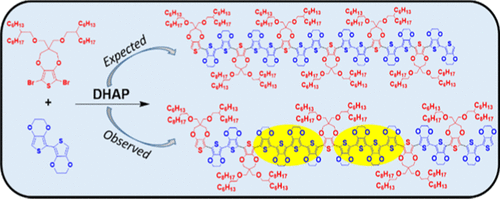当前位置:
X-MOL 学术
›
Macromolecules
›
论文详情
Our official English website, www.x-mol.net, welcomes your
feedback! (Note: you will need to create a separate account there.)
Curious Case of BiEDOT: MALDI-TOF Mass Spectrometry Reveals Unbalanced Monomer Incorporation with Direct (Hetero)arylation Polymerization
Macromolecules ( IF 5.1 ) Pub Date : 2020-08-20 , DOI: 10.1021/acs.macromol.0c01093 Austin L. Jones 1 , Michel De Keersmaecker 1 , Ian Pelse 1 , John R. Reynolds 1
Macromolecules ( IF 5.1 ) Pub Date : 2020-08-20 , DOI: 10.1021/acs.macromol.0c01093 Austin L. Jones 1 , Michel De Keersmaecker 1 , Ian Pelse 1 , John R. Reynolds 1
Affiliation

|
Homocoupling defects in conjugated polymers often go undetected but may cause significant batch-to-batch variations that ultimately give seemingly identical polymers different material properties. These defects may go easily unnoticed because conjugated polymers are commonly characterized via gel-permeation chromatography and elemental analysis, two techniques that are not able to provide information on monomer incorporation or end groups. Nuclear magnetic resonance spectroscopy has provided evidence of homocoupling defects, but is limited to polymeric repeat units with distinct chemical shifts and little spectral overlap, a luxury unavailable in polymeric dioxythiophenes. Here, matrix-assisted laser desorption/ionization time-of-flight (MALDI-TOF) mass spectrometry (MS) was used to characterize different dioxythiophene copolymer (PE2) batches based on 3,4-propylenedioxythiophene (ProDOT) and 2,2′-bis-(3,4-ethylenedioxy)thiophene (biEDOT) to elucidate changes in structure within different polymer batches. It was determined through the analysis of MALDI-TOF mass spectra that excess biEDOT is incorporated into PE2 when using standard direct (hetero)arylation polymerization (DHAP) conditions. It is hypothesized that the high nucleophilicity of biEDOT causes uncontrolled concerted metalation–deprotonation steps in the DHAP catalytic cycle at high temperatures. To improve control of the biEDOT incorporation, the reaction temperature was lowered from 140 to 80 °C, and a different polymerization procedure was used where the reaction temperature was ramped-up from room temperature. Ultimately, incorporation of excess biEDOT was advantageous to the conductivity of oxidatively doped polymer films, with values greater than 200 and 80 S/cm for the high- and low-temperature polymerizations, respectively. This work correlates small differences in polymer structure with solid-state conductivity to expose how batch-to-batch variations regarding homocouplings can produce different material properties.
中文翻译:

BiEDOT的一个奇怪案例:MALDI-TOF质谱揭示了不平衡单体与直接(杂)芳基化聚合反应的结合
共轭聚合物中的均质偶联缺陷通常未被发现,但可能会导致批次间的显着差异,最终使看似相同的聚合物具有不同的材料性能。由于共轭聚合物通常通过凝胶渗透色谱法和元素分析来表征,而这两种技术无法提供有关单体掺入或端基的信息,因此这些缺陷可能容易被忽视。核磁共振波谱已经提供了均偶联缺陷的证据,但仅限于具有明显化学位移和几乎没有光谱重叠的聚合物重复单元,这在聚合物二氧噻吩中是不存在的。在这里,基质辅助激光解吸/电离飞行时间(MALDI-TOF)质谱(MS)用于表征不同的二氧噻吩共聚物(PE2)基于3,4-丙二氧基噻吩(ProDOT)和2,2'-双-(3,4-乙二氧基)噻吩(biEDOT)的批次,以阐明不同聚合物批次中的结构变化。通过对MALDI-TOF质谱的分析确定,过量的biEDOT被掺入到PE 2中使用标准的直接(杂)芳基化聚合(DHAP)条件时。据推测,biEDOT的高亲核性会导致高温下DHAP催化循环中失控的协同金属化-去质子化步骤。为了改善对biEDOT掺入的控制,将反应温度从140降低至80℃,并使用不同的聚合程序,其中反应温度从室温升高。最终,掺入过量的biEDOT有利于氧化掺杂的聚合物薄膜的电导率,对于高温和低温聚合,其值分别大于200和80 S / cm。
更新日期:2020-09-09
中文翻译:

BiEDOT的一个奇怪案例:MALDI-TOF质谱揭示了不平衡单体与直接(杂)芳基化聚合反应的结合
共轭聚合物中的均质偶联缺陷通常未被发现,但可能会导致批次间的显着差异,最终使看似相同的聚合物具有不同的材料性能。由于共轭聚合物通常通过凝胶渗透色谱法和元素分析来表征,而这两种技术无法提供有关单体掺入或端基的信息,因此这些缺陷可能容易被忽视。核磁共振波谱已经提供了均偶联缺陷的证据,但仅限于具有明显化学位移和几乎没有光谱重叠的聚合物重复单元,这在聚合物二氧噻吩中是不存在的。在这里,基质辅助激光解吸/电离飞行时间(MALDI-TOF)质谱(MS)用于表征不同的二氧噻吩共聚物(PE2)基于3,4-丙二氧基噻吩(ProDOT)和2,2'-双-(3,4-乙二氧基)噻吩(biEDOT)的批次,以阐明不同聚合物批次中的结构变化。通过对MALDI-TOF质谱的分析确定,过量的biEDOT被掺入到PE 2中使用标准的直接(杂)芳基化聚合(DHAP)条件时。据推测,biEDOT的高亲核性会导致高温下DHAP催化循环中失控的协同金属化-去质子化步骤。为了改善对biEDOT掺入的控制,将反应温度从140降低至80℃,并使用不同的聚合程序,其中反应温度从室温升高。最终,掺入过量的biEDOT有利于氧化掺杂的聚合物薄膜的电导率,对于高温和低温聚合,其值分别大于200和80 S / cm。











































 京公网安备 11010802027423号
京公网安备 11010802027423号